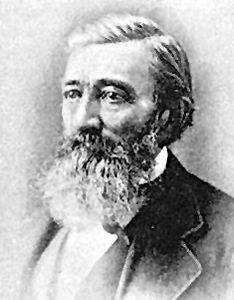
Echoes from the Peaks: The Enduring Legend of George Simpson, Colorado Trader
America’s soul is etched with stories, a vibrant tapestry woven from the threads of history, ambition, and the untamed wilderness. From the seafaring sagas of the East to the sun-baked myths of the Southwest, these legends define a nation constantly reinventing itself. Yet, perhaps no frontier spawned more potent or evocative tales than the American West – a land of towering peaks, endless plains, and the raw, unvarnished spirit of those who dared to tame it. Among these figures, often lost in the broader sweep of history but preserved in the campfire whispers and local lore, stands the enigmatic persona of George Simpson, the Colorado Trader.
While not a figure of national renown like Daniel Boone or Kit Carson, Simpson’s legend, like the rugged mountains he traversed, is deeply rooted in the soil of Colorado. He embodies a specific archetype: the indispensable, often solitary, intermediary who bridged the chasm between burgeoning civilization and the indigenous cultures, between scarcity and supply, and between the known and the perilous unknown. His story, pieced together from fragments of local memory and the collective imagination, offers a fascinating glimpse into the making of a Western legend and the profound impact of those who navigated its most challenging terrains.
The Crucible of the Rockies: Colorado’s Untamed Promise

The mid-19th century transformed Colorado from a remote, largely unexplored territory into a focal point of American expansion. The discovery of gold in the Pikes Peak region in 1858-59 triggered one of the most significant migrations in U.S. history. Thousands flocked westward, driven by dreams of instant wealth, leaving behind established comforts for the harsh realities of the frontier. Denver, a dusty settlement at the confluence of Cherry Creek and the South Platte River, rapidly bloomed into a boomtown.
But the gold seekers and nascent settlers faced immense challenges. Supplies were scarce and expensive, transportation routes perilous, and the vast wilderness was home to powerful Native American nations – the Ute, Cheyenne, and Arapaho – whose lands and way of life were increasingly threatened. It was in this volatile, vibrant crucible that figures like George Simpson carved their legends.
The "trader" was more than just a merchant; he was an explorer, a diplomat, a linguist, and a survivalist rolled into one. He understood the intricate dance of supply and demand, the subtle nuances of intercultural communication, and the unforgiving whims of the Rocky Mountain weather. He brought essentials – tools, ammunition, blankets, coffee, whiskey – to isolated mining camps and burgeoning towns, often venturing into territories where few white men dared to tread. In return, he sought furs, gold dust, or goods produced by Native American artisans.
The Man Behind the Myth: George Simpson’s Persona
The legend of George Simpson begins with his arrival – or rather, his perceived emergence from the wilderness. Unlike many who arrived in dusty wagons, Simpson seemed to simply materialize along the treacherous mountain trails, his pack mules laden with goods, his eyes reflecting the deep wisdom of the wild. Accounts, often embellished through years of retelling, paint a picture of a man of medium height but wiry strength, his face weathered by sun and wind, his gaze steady and knowing. He was said to possess an almost preternatural ability to navigate the labyrinthine passes and canyons of the Colorado Rockies, a skill honed by years of solitary travel.
"They say he could smell a blizzard a week off, or tell you what game was in a valley just by the way the wind shifted," an old prospector’s anecdote, oft-repeated around campfires, might have gone. Such observations transformed a skilled woodsman into something more: a man attuned to the very pulse of the land.
Simpson’s linguistic prowess was another cornerstone of his legend. He was reputed to speak several Native American languages, particularly Ute, with fluency. This was not merely a convenience but a necessity, fostering trust and enabling peaceful trade where others met with suspicion or hostility. He understood the protocols, the courtesies, and the deeper meanings behind the words, earning him a unique standing among the tribes. "The Utes called him ‘Wolf’s Shadow’," a local historian might speculate, "for his silent movement and his ability to see what others missed, to move between worlds." This ability to bridge cultural divides, to walk unharmed through territories deemed hostile by others, was perhaps his most potent claim to legendary status.
Traversing the Treacherous Trails: Exploits and Endeavors

Simpson’s routes were as legendary as the man himself. He wasn’t confined to the well-trodden Santa Fe Trail or the fledgling Denver roads. Instead, whispers told of his secret passes through the Sangre de Cristo Mountains, his solitary journeys across the vast San Luis Valley, and his daring forays deep into Ute hunting grounds. He was the vital link that connected isolated mining claims to the growing towns, the man who brought news and supplies, and sometimes, a glimmer of hope, to those teetering on the edge of despair.
One oft-repeated tale involved a harsh winter when a remote mining camp, perhaps near present-day Leadville or Creede, was cut off by an unprecedented snowfall. Supplies dwindled, and starvation loomed. When all seemed lost, George Simpson, against all advice, appeared with a train of hardy mules, their packs laden with flour, salt, and medical supplies. How he found a path through drifts feet deep, or how he convinced his mules to endure such conditions, became a testament to his indomitable will and his profound understanding of the mountain environment. He didn’t just survive; he conquered the elements, often doing so when others had given up.
Another facet of his legend was his shrewdness as a trader. While fair, he was also astute, knowing the true value of his goods and the market dynamics of the frontier. He was not one to be cheated, nor did he seek to exploit. His reputation for honest dealing, even with those on the fringes of society, solidified his standing. "Simpson always paid his debts, and he always got his price," a grizzled teamster might have grumbled admiringly, acknowledging a fundamental respect for the man. This balance of fairness and acumen made him a trusted, if sometimes formidable, presence.
The Silent Diplomat and the Shadow of Conflict
The West was not a monolithic entity of white expansion; it was a complex mosaic of cultures, each with its own claims and grievances. George Simpson operated within this intricate web, often serving as an unofficial, yet critical, mediator. His relationships with various Native American tribes, particularly the Utes, were unique. He understood their reverence for the land, their intricate social structures, and the injustices they faced. He wasn’t a missionary or a soldier; he was a businessman who understood that mutual respect facilitated trade and survival.
"He knew how to listen," a fictionalized Ute elder might have recounted in the lore, "He didn’t just speak with his tongue, but with his eyes and his heart." This deep level of understanding allowed him to navigate the simmering tensions between settlers and tribes, often diffusing potential conflicts before they erupted into violence. While he was a man of the white world, his ability to move freely and peacefully in Native American territories lent him an aura of mystery and respect among both populations.
Yet, Simpson’s legend also carried the shadow of the era’s inevitable conflicts. While he promoted peace, he was no stranger to danger. Tales of narrow escapes from bandit gangs, encounters with hostile wildlife, and traversing areas where skirmishes between settlers and tribes were frequent, added to his mystique. He was a survivor, not by brute force alone, but by a combination of cunning, foresight, and an uncanny ability to read situations.
The Enduring Whisper: Simpson’s Legacy
Like many frontier legends, the exact details of George Simpson’s eventual fate remain shrouded in mystery, which only serves to deepen his mystique. Some say he simply disappeared, vanishing into the mountains he knew so well, perhaps to live out his days among a secluded Ute band, or to discover a hidden valley of unimaginable beauty. Others claim he eventually settled down, a quiet man running a trading post, his past adventures hinted at only by the faraway look in his eyes. This ambiguity is crucial to his legend; it allows the imagination to fill in the blanks, ensuring his spirit remains alive in the peaks and valleys of Colorado.
What George Simpson, the Colorado Trader, represents is more than just a man. He is the embodiment of the frontier spirit: self-reliance, resourcefulness, courage, and an innate understanding of the natural world. He is the archetype of the independent operator, the one who carved out a living on the very edge of civilization, bridging gaps and forging paths where none existed. His legend speaks to the human need for connection, even in the most isolated of places, and the profound impact of individuals who, through skill and character, manage to transcend cultural divides.
In a modern Colorado teeming with bustling cities and ski resorts, the echoes of George Simpson’s journeys might seem faint. Yet, for those who venture into the deeper recesses of the Rockies, who feel the immensity of the landscape and ponder the lives of those who first braved its challenges, the legend of the Colorado Trader persists. It’s a reminder that America’s grand narrative is not solely built on presidents and generals, but also on the countless unsung heroes, the quiet navigators, and the enigmatic figures like George Simpson, whose footsteps, though faded, forever mark the trails of the American West. His story, a blend of historical context and imaginative embellishment, continues to resonate, a testament to the power of human endurance and the enduring allure of the wilderness.


